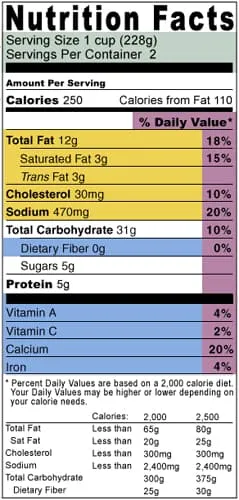Food labels can help you make better decisions about what you eat and how you manage your diabetes.
Just about every packaged food made in the U.S. has a "Nutrition Facts" label that gives a serving size and other nutritional information. It has measurements of fat, cholesterol, sodium, carbohydrates, protein, vitamins, and minerals for a typical amount of that food. This information can make it easier for you to choose foods that will fit into your meal plan and help control your blood sugar, cholesterol, blood pressure, and weight.
Here's an example of a Nutrition Facts label. Find out more about its parts below.

Serving Size
A serving size is a standard measurement based on the amount of food people typically have at one time. The size of the serving determines the amounts listed on the label. It helps you figure how many calories and nutrients are in your food on your plate.
Pay attention to that serving size, including the number of servings in the package, and compare it to how much you're actually eating. Don't confuse portion size with serving size. A portion is what you choose to eat -- and there are no standard measures for this.
For example, if a slice of bread is a serving size and you eat a sandwich with two slices of bread, you've had two servings of bread in your one portion, so you'll have to double all the nutritional numbers like calories and carbs. If a package has four servings and you eat the whole thing (like a bag of crunchy snacks), you get 4 times the calories, fat, and everything else listed on the label.
Calories and Calories From Fat
Calories measure energy, so this number tells you how much energy you get from one serving. (Remember, you'll need to adjust this if your portion is different from the serving size on the label.)
This part of the label also tells you how much of that energy comes from the fat in a serving.
Nutrients
"% Daily Value" shows how much a serving of that food gives you for each key nutrient listed. These daily goals are set by the government, based on current nutrition recommendations. The percentages are based on a 2,000 calorie/day diet, which would be right for an average- or large-size man who gets little exercise. Women or seniors with diabetes, or people trying to lose weight, need fewer calories.
If your daily calorie intake isn't 2,000, you may need to do a little math. Some nutrient goals change with the number of daily calories. Some, including sodium and calcium, are based on things like your age, sex, or health, not the number of calories you eat. Talk to your doctor or your diabetes educator about how to adjust the % Daily Values on labels for your diet.
In general, when it comes to fat, saturated fat, cholesterol, and sodium, choose foods with a low % Daily Value. For total carbohydrates, dietary fiber, as well as vitamins and minerals, try to reach your daily target for each nutrient.
Ingredients
Every product should list all the ingredients in it. They're in order from the largest to smallest amount, by weight. This means a food is made up of the heaviest amount of the first ingredient and the least amount of the last ingredient.
Label Claims
Some food labels make claims such as "low cholesterol" or "low fat." A manufacturer can only use these words if a food meets strict government definitions:
| LABEL CLAIM | DEFINITION (per standard serving size) |
| Fat-free* or sugar-free | Less than 0.5 gram (g) of fat or sugar |
| Low fat | 3 g of fat or less |
| Reduced fat or reduced sugar | At least 25% less fat or sugar than the regular product. |
| Cholesterol free | Less than 2 milligrams (mg) cholesterol and 2 g or less of saturated fat |
| Reduced cholesterol | At least 25% less cholesterol and 2 g or less of saturated fat |
| Calorie free | Less than 5 calories |
| Low calorie | 40 calories or less |
| Light or lite | 1/3 fewer calories or 50% less fat |
Other important terms found on food labels have to do with the amount of salt or sodium. Remember that 1 teaspoon has 2,000 mg.
| LABEL CLAIM | DEFINITION |
| Sodium-free or salt-free | Less than 5 mg per serving |
| Very low sodium | 35 mg or less of sodium per serving |
| Low sodium | 140 mg or less of sodium per serving |
| Low sodium meal | 140 mg or less of sodium per 3 1/2-ounce meal |
| Reduced or less sodium | At least 25% less sodium than the regular version |
| Light in sodium | 50% less sodium than the regular version |
| Unsalted or no salt added | No salt added to the product during processing |

